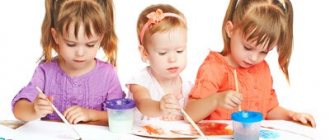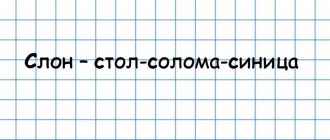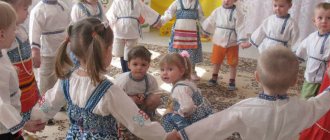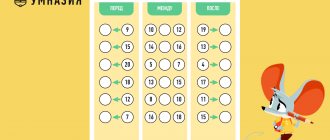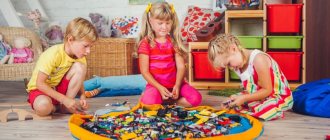Perhaps every modern person has heard of photographic memory - the ability to instantly remember large amounts of data presented on visual media. This skill allows you to receive information better, so many parents would like to instill it in their child. But most people are sure that instant memory of what they see is just a phenomenon, and it is impossible for an ordinary person to achieve such a level. In this article we will try to figure out: “How to develop photographic memory? And is it possible to do this?
Child's memory
In the modern world, education plays a vital role. How well a person will receive it largely depends on the ability to productively assimilate the information received. Since we begin to learn from an early age, it is important to develop a child’s memory from childhood. There are several types of it:
- Visual. We most often use it to receive and remember data about the world around us. It is this that allows us to absorb large amounts of knowledge from books and electronic media. It is a fundamental factor for high-quality receipt and memorization of information in various disciplines of schools and universities.
- Auditory. The ability to perceive information by ear is available to us from early childhood. When a baby is born, he is not yet able to focus on surrounding objects, but he perfectly remembers the voices of loved ones. When a child grows up a little, it is thanks to hearing that he remembers the sounds that animals, nature, and transport make.
- Motor or motor. It allows a person to know how to correctly perform a particular physical action. We don’t think about it when we write in a notebook, since our muscles remember what movements must be followed to draw a particular sign. Thanks to this, we perform many actions mechanically, because they are honed and reinforced in practice.
- Olfactory, tactile and gustatory. These types of memory allow us to remember various pleasant and not so pleasant sensations: what a lilac smells like, what a watermelon tastes like, how painful it is if you prick yourself with a sewing needle. Thanks to such information, a person manages to exist safely in the world around him, avoid dangers and strive for his own comfort.
Children's games in memory formation
Outdoor games for the development of preschool children
Children in preschool age move a lot, so outdoor games or play exercises with objects: a ball, pins, hoops will be relevant. The main thing is that the games are appropriate for the child’s age and are selected by parents in accordance with the rules.
"Mirror"
A relevant game for kids when they need to develop memorization, retention, and motor memory.
The adult says to the child: “Let's play in the mirror. Remember what movements I show you and repeat them.” The child performs movements, at first simple, then, as the rules are mastered, more and more complex.
For older children, such fun can turn into an intense game of “Forbidden Movements”, when, on the contrary, the shown movements cannot be repeated.
Ancient ball game "I know..."
This game can be offered to children of all ages. The fun is aimed at developing auditory memory, mental activity and coordination of movements. The child hits the ball on the ground and, in time with the hits, pronounces the words: “I know three names of girls (boys).” Names cannot be repeated.
As an option for the game, you can use the names of cities, vegetables, fruits, flowers, etc. For older children, the number of items increases to 5.
"Ocean is shaking"
A classic game exercise to develop the processes of memorization and reproduction. It is better to spend it with a group of children of different ages: on vacation, in the family circle, during a children's party.
The players make up different figures. The driver closes his eyes and says: “The sea is worried - one, the sea is worried - two, the sea is worried - three, the sea figure freezes in place.” Children perform various movements: run, jump, squat. At the end of the words, everyone stops in a certain position. The driver opens his eyes and carefully examines the “frozen figures.” He must remember how the players were positioned and correct their positions.
"Restore your figure"
Playing with pins in a small town style helps develop visual memory, memorization and reproduction processes.
An adult and a child build a figure out of pins and ask them to remember it. Then the figure is knocked down with the ball, the child must restore it. The fun takes place interestingly in nature, in the family circle, during outdoor holidays.
Story games for developing memory processes
Story play is a favorite leisure activity for preschoolers of all ages. Such games are related to life situations, and therefore arouse genuine interest in children. Parents can successfully use story activities at home. When playing with kids, you can take on one of the main roles in the plot. With older children, adult participation may be sporadic. You need to start playing games with kids with simple situations, using familiar household items, dishes, and cereals.
"Shop"
The plot develops all processes: memorization, preservation, reproduction, and helps to form auditory memory. Children of all ages can play.
With kids, the parent takes on the role of a seller, offering to remember what needs to be bought in the store, for example, for pies. Older children can play the leading role themselves, inviting others to make various purchases. In the game you can teach children special memorization techniques (mnemonics). For example, invite a preschooler to prepare a note with symbols of purchases.
"Hospital"
Another story-based game that preschoolers love to play. It helps to develop all memory processes, auditory and visual. The adult invites the child to take on the role of a “doctor,” remember how he is treated when he is ill, and then cure the “sick” bear. First, you need to discuss with the baby the sequence of all actions: first put the “sick” to bed, listen with a phonendoscope, measure the temperature, put a tablet under the tongue, prepare a mixture, etc.
"Holiday"
The game is interesting for all children, but older preschoolers can prepare it on their own. With kids, an adult must be extremely active, since all actions require special preparation: attributes, drawing invitation cards, arranging a play space. The plot can be varied: a New Year's holiday, a doll's birthday, a festive tea party, etc. Guest toys are prepared, the actions of the players are discussed, and roles are assigned. The game will be more fun if children of different ages take part in it.
"Zoo"
An exciting game for children of different ages, it helps develop the processes of attention and memory: preservation, reproduction, and combating forgetting.
The preschooler needs to remember what animals live in the zoo. For the game, you can prepare pictures of animals or animal figures. An adult and a child walk around the zoo, examining its inhabitants, remembering their habitat, appearance, and habits. After some time, the preschooler is asked to look at pictures with different animals and remember which ones were in the zoo and which ones are yet to be placed there. This game takes a long time because the plot is constantly updated. Riddles about animals are good for developing the plot. They not only enrich the preschooler’s speech, but also help form the processes of memorization and reproduction, and teach mnemonic techniques (associations, comparisons, grouping). For example, “Instead of a nose there is a trunk, instead of legs there are pillars, and they stand like gray mountains...”, “He walks in our zoo, he surprises with his long neck. It’s tall, like a closet, yellow, with spots...”
In the plots of such games, you can also use folk nursery rhymes, songs, and rhymes, which help improve the memory of preschoolers and form memorization skills. For example, “preparing lunch”:
Carcasses-tattoos, Baked cheesecakes! They put it on the window and left it to cool. And the wheat pie - It is mixed with maggots, So high, high!
Or “we’re going to visit”:
The gray bunny is dressing up, apparently going to visit. I washed my nose, washed my forehead, washed my ear, wiped it dry. He put on a bow and became a dandy.
Didactic games for memory development
There are special (didactic) games aimed at improving all types of memory. Basically, they are educational in nature and require special training and the necessary gaming material. Despite the rather large time investment, didactic games give good results because they are both exercises for memory development and games for the development of all mental processes in a complex.
"Wonderful bag"
The classic game in various versions can be played with three-year-old children who have ideas about the world around them. The parent invites the child to find an object by touch and tell about it from memory without removing it from the bag, for example, a round smooth ball, a soft fluffy toy, a wooden cube, etc. Older preschoolers can be offered new and complex objects that differ from each other in shape, quality, size: smooth and rough, cold and warm, ball and cube, metal and wood, small and large toy.
"Guess what's changed?"
The game has become a classic in pedagogical practice and is relevant for younger preschool children who are just beginning to learn about memorization techniques. The parent invites the child to remember and count by order (first, second, third, ...) the toys that are in front of him. Then the child closes his eyes or leaves the room, and the adult changes places or hides a toy. Kids like to guess what has changed, what is missing, and where this or that toy is now.
"Lotto"
The game develops visual memory, teaches memorization techniques (multiple repetition, grouping of words, generalization). An adult and a child play together, the one who covers his playing field faster wins. The subject can be objects of different classifications: vegetables, fruits, animals, furniture, clothing, natural phenomena.
“Cut pictures” or puzzles
Games of this kind are accessible to children of all ages; they help develop all mental processes in a complex: you need to be attentive, remember which part of the picture is collected, correlate the sample and the collected part of the picture.
Creative games for older preschoolers
Starting from senior preschool age, children can be offered verbal educational games. They help not only to develop auditory memory, but also to consolidate the skills of using mnemonic techniques (associations, grouping, generalization).
"Magic Words"
Option 1 – association game. The presenter thinks of a word, breaking it into syllables and making a new word from each part. Players must guess the hidden concept using association words. For example, the word “airplane” is thought of: sa (sledge) - mo (milk) - let (fly), associations are suggested:
Sleds - everyone loves to ride them down the hill. Milk - cows provide healthy liquid to children. Fly - butterflies, birds, beetles do this.
Ultimately, the intended word is assembled from the syllables. The winner receives a forfeit.
Option 2 – the words that are offered to the baby are remembered using generalization words. You can ask the child to name the extra object, to name the objects in one word. For example, “maple, birch, linden, poplar, spruce, aspen (all deciduous trees, and spruce is a coniferous tree)”, “red, white, orange, blue, pink - colors.”
Option 3 – words – “C”, memorizing words using grouping according to some attribute. For example, cow - milk - cottage cheese, paper - pencil - drawing, flower - vase - mother, summer - sun - water. The presenter offers to remember three words, connecting them with a plot, and remember the rest based on the first word. To develop memorization skills, the game begins with two “C” marks, then their number gradually increases. The player who groups and remembers the words best wins and receives a prize. If it is difficult for a preschooler to concentrate on the educational material, at first you can offer support for pictures.
Visual memory - what is it?
Visual memory is most often used by a person when receiving information. From childhood, a child examines the world around him and learns its diversity with his own eyes. When he enters the first grade, it is thanks to her that he receives most of his knowledge: from the school board, from textbooks and teaching aids, the child learns mathematical formulas and rules of the Russian language, gets acquainted with literary works and paintings by world-famous artists.
How well a child’s ability to remember is developed directly determines his academic performance. Children who are poorer learners have a harder time than their peers because they spend more time doing class exercises and preparing homework.
A well-developed visual memory is the key to a successful future for a person. Those students who are able to memorize information easily prepare more effectively for passing final exams at school for admission to a higher educational institution. At a university, a student is also faced with large amounts of knowledge in various subjects, which he simply needs to learn and consolidate. Therefore, it is important to develop skills in receiving and processing information.
There are many exercises on the Internet that, according to their creators, can improve visual memory. However, most often, they do not provide a systematic approach, which is simply necessary for such activities. It is important to understand that the highest result of the development of visual memory is the ability to instantly remember what you see down to the smallest detail, as if photographing and storing what you saw in the depths of your own mind.
Training auditory memory
The more we train our memory, the more we can remember. So, let’s begin exercises to develop auditory memory in younger schoolchildren. Classes can be conducted both in groups and individually.
- Add yours
This exercise is good to practice in a group. This is the principle here. An adult suggests a simple plot, for example, a trip or a trip to the store. It starts like this: “I put a book in my suitcase (bag). The child must repeat this sentence from the beginning and add something of his own. For example: “I put a book and pencils in my suitcase (bag). The second participant in the class repeats everything from the beginning again (the phrase is already longer) and adds his own.
- Remember the rhythm
With a pencil or stick, you tap on the table in a certain rhythm and invite the child to repeat it. You need to start with simple sounds; as the student masters it, the rhythm can be complicated.
- Let's sing songs
For the development of auditory memory, such a simple technique as singing songs in the voices of familiar cartoon characters, for example, effectively helps. In order to imitate someone else's voice, the child will have to remember its timbre, volume, intonation and rhythm.
- Looking for a couple
The training consists of two stages. In the first stage, you read pairs of words. For example: flower - vase, school - student, hare - forest, river - bank. At the second stage, you name one word from the read pair and invite the child to name the second. If your student copes, then everything is fine with both memory and logic.
- Let's play in associations
This is a more challenging exercise, although your child will definitely enjoy it. Prepare several cards on which you depict objects and animals. For example, fox, sweater, sun, bus. Place the cards in front of your child. Set a task: you name the words, and the child selects a picture to go with them. Words could be: forest, clothes, weather, garage.
Photographic memory in a child
Photographic memory is a high level of development of visual memory, at which a person is able to remember and reproduce in detail previously seen images in his mind. People with it are able to receive and process information at amazingly high speeds: they only need to look at the page of a book to remember it, and then retell the text in great detail.
Many scientists studying the work of intelligence are struggling to unravel such a phenomenon as photographic memory, as well as the possibility of its development. It is believed that many famous people owned it: Nikola Tesla, Theodore Roosevelt, Sergei Rachmaninoff. But it is a mistake to believe that possessing this skill is only a lucky coincidence, a feature of genetics. Perhaps some people are truly lucky to be born with such an amazing ability to remember information, but often photographic memory is the result of working on oneself.
It is quite natural that parents would like to develop such a skill in their children. The ability to easily assimilate and apply knowledge will make it easier to complete training and successfully move up the career ladder. Considering that a person is best equipped with skills acquired at an early age, it is better to develop a child from childhood. But is it possible to develop photographic memory, and how can this be done quickly?
There are a number of techniques that offer various exercises for developing this area of intelligence. Many of them have proven their effectiveness, which means that a modern child can develop visual memory to the level of photographic memory, but this cannot be done quickly. It is also important to choose the right training program so that your efforts are not wasted.
What types of memory are there?
To choose appropriate exercises for memory development, it is worth understanding how the memorization process occurs. To do this, let us turn to the generally accepted classification of memory.
- By duration:
- short-term (information is remembered easily, but also easily forgotten);
- long-term (data is stored in memory for a long time);
- prompt (information is retained for some time).
- Type:
- auditory (what is heard is better remembered);
- visual (visual images are easier to remember);
- motor (everything related to movement - remembers the body);
- figurative (emotional, associative);
- By degree of effort:
- involuntary (no effort required to remember anything);
- arbitrary (you need to try to remember an event or object);
- immediate (memorized mechanically, thinking does not “turn on”);
- indirect (requires building a logical chain, understanding the data).
By the way, children have a well-developed mechanical memory, so experts recommend starting to study foreign languages before school.
How does human memory work? There are three stages here:
- memorization;
- data storage;
- retrieval (reproduction) of data.
Ways to develop photographic memory in children
In order to develop the ability to quickly remember information, there are a huge variety of different exercises. They can be simple, for the youngest children, or more complex, for older children and adults. Let's look at the most popular exercises:
- Exercises related to observation. There are a large number of variations, but the essence of these exercises is approximately the same: a person focuses on an image (a picture in a book or the Internet, an advertising brochure, a sign on the street), tries to examine and remember all its details as much as possible. Then you need to close your eyes and try to recreate the image, and then compare it with the original.
- Exercises for visualizing information. It is necessary to select associations with the images. This exercise allows you to speed up the recall of previously learned information.
- Sequence memorization exercises. You can take a numerical expression, a mathematical formula, or just a set of different symbols, try to remember it, and then recreate it on paper. For this exercise, it is important to use sequences of signs that would be unfamiliar to a person.
- Exercises related to rearrangement. To complete this exercise, you can prepare the necessary materials yourself. You need several cards of the same size with different images. Place them in a random order on the table, take a photo of the result, then mix them and try to recreate their original order. Compare with photo. There are also many variations of this exercise on the Internet.
Undoubtedly, these exercises can help improve the ability to remember what you see. But, unfortunately, their implementation cannot be compared with a structured, consistent approach to developing this skill. In addition, it is difficult for a child to study independently and maintain motivation for a long time. For this reason, it is better to entrust children’s memory training to professionals - qualified teachers.
Today, there are many additional development centers that offer classes to improve a child’s memory. Give preference to those institutions that teach using original, time-tested methods. Over time, such activities will bear fruit: the child’s performance at school will increase, studying will begin to be easier, fatigue of the nervous system will decrease, since completing homework will take much less time. In addition, such courses are a good investment in the child’s future, in the development of his intellect.
How to develop long-term memory?
Human memory is quite subjective, since after each subsequent reproduction of information, memories are distorted.
The task of parents is to develop and train the child’s long-term memory. To do this you need:
- Teach your child the ability to compare objects of memorization, find similarities and differences in them (children's magazines with colorful pictures and tables are suitable for training, in which you are asked to find either identical objects or find subtle differences in them);
- Practice retelling by the child any information he has received - a cartoon he has watched, a story he has read, an experience he has experienced (trains memory, develops speech, allows him to correctly compose sentences);
- Learn poems, tongue twisters, solve crosswords;
- Gradually move on to memorizing prose (one interesting exercise can be suggested here). For example, read a small passage of text in a magazine and cut out this fragment. Then cut it into pieces, give the child one part and offer to reconstruct the entire plot from it.
Developing associative memory
The development of associative memory in elementary school students is a very effective method. There is a whole science for training the formation of associations - mnemonics. Exercises to develop associations include diagrams, tables, pairs of words that are not related in meaning. Regarding the latter, name a couple of words that have different meanings and give the child the task of coming up with a story using these words. And diagrams and tables with pictures will teach children to write stories; perform some manipulations in a certain sequence, for example, getting dressed. Mnemonic diagrams help increase vocabulary and quickly memorize text. They say that a poem is best remembered if you “see” it.
